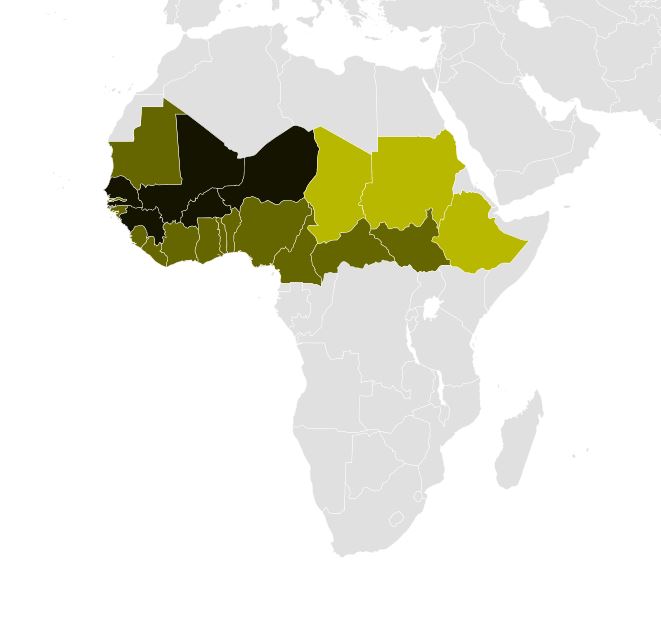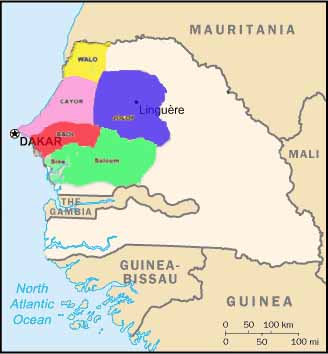|
Lake Guiers
The Lac de Guiers or Lake Guiers is a lake in northern Senegal, south of the city of Richard-Toll and in the Louga and Saint-Louis regions. It is a chief source of fresh water for the city of Dakar, hundreds of kilometers to the south-west, through underground pipes. It is about 35 kilometers long and 8 kilometers wide, and is supplied by the Ferlo or Bounoum River, which flows north into its southern end, from Fouta in the rainy season. Water flows out to the Senegal River north through the , which has been straightened and canalized as it passes through Richard-Toll. A dam was built in 1916 to prevent saltwater flowing in. The shores are mostly fertile. The north shore and surrounding area have been converted to a large sugar-growing region irrigated with water from the lake. Lac de Guiers is designated an Important Bird Area by BirdLife International; the key species are lesser flamingo (''Phoeniconaias minor''), glossy ibis (''Plegadis falcinellus''), Eurasian spoonbi ... [...More Info...] [...Related Items...] OR: [Wikipedia] [Google] [Baidu] |
Senegal
Senegal, officially the Republic of Senegal, is the westernmost country in West Africa, situated on the Atlantic Ocean coastline. It borders Mauritania to Mauritania–Senegal border, the north, Mali to Mali–Senegal border, the east, Guinea to Guinea–Senegal border, the southeast and Guinea-Bissau to Guinea-Bissau–Senegal border, the southwest. Senegal nearly surrounds The Gambia, a country occupying a narrow sliver of land along the banks of the Gambia River, which separates Senegal's southern region of Casamance from the rest of the country. It also shares a maritime border with Cape Verde. Senegal's capital is Dakar. Senegal is the westernmost country in the mainland of the Old World, or Afro-Eurasia. It owes its name to the Senegal River, which borders it to the east and north. The climate is typically Sahelian, though there is a wet season, rainy season. Senegal covers a land area of almost and has a population of around 18 million. The state is a Presidential system ... [...More Info...] [...Related Items...] OR: [Wikipedia] [Google] [Baidu] |
Eurasian Spoonbill
The Eurasian spoonbill (''Platalea leucorodia''), or common spoonbill, is a wading bird of the ibis and spoonbill family Threskiornithidae, native to Europe, Africa and Asia. The species is partially migratory with the more northerly breeding populations mostly migrating south for the winter. Taxonomy The Eurasian spoonbill was Species description, formally described in 1758 by the Swedish naturalist Carl Linnaeus in the 10th edition of Systema Naturae, tenth edition of his ''Systema Naturae'' under the current binomial nomenclature, binomial name ''Platalea leucorodia''. Linnaeus cited works by earlier authors including the description and illustration by the English naturalist Eleazar Albin that was published in 1734. Linnaeus specified the type locality (biology), type locality as Europe but restricted it to Sweden in 1761. The genus name ''Platalea'' is Latin and means "broad", referring to the distinctive shape of the bill; the specific epithet ''leucorodia'' is from Ancient G ... [...More Info...] [...Related Items...] OR: [Wikipedia] [Google] [Baidu] |
Fula People
The Fula, Fulani, or Fulɓe people are an ethnic group in Sahara, Sahel and West Africa, widely dispersed across the region. Inhabiting many countries, they live mainly in West Africa and northern parts of Central Africa, South Sudan, Darfur, and regions near the Red Sea coast in Sudan. The approximate number of Fula people is unknown, due to clashing definitions regarding Fula ethnicity. Various estimates put the figure between 25 and 40 million people worldwide. A significant proportion of the Fula – a third, or an estimated 7 to 10 million – are pastoralism, pastoralists, and their ethnic group has the largest nomadic pastoral community in the world., Quote: The Fulani form the largest pastoral nomadic group in the world. The Bororo'en are noted for the size of their cattle herds. In addition to fully nomadic groups, however, there are also semisedentary Fulani – Fulbe Laddi – who also farm, although they argue that they do so out of necessity, not choice. The major ... [...More Info...] [...Related Items...] OR: [Wikipedia] [Google] [Baidu] |
N'Der
N'Der (also spelled Nder or Ndeer) is a small town on the western shore of the Lac de Guiers, in northern Senegal. It was the third and last capital of Waalo until the annexion of the kingdom by France in 1855. Geography N'Der is located on the Western shore of the Lac de Guiers. The nearest settlements are Sadiale, Nieti Yone, Mbane and Naere. History In 1733, N'Der became the third capital in the history of Waalo as Brak Njak Aram moved there from Njurbel, the previous capital. N'Der resistance In 1819, as the Brak Amar Fatim Borso and most of his warriors had traveled to Saint-Louis to have their wounds treated at the French hospital after a battle against Trarza Moors, the undefended capital became the target of a slave raid by the Trarza army. After sending their children to hide in the fields, the women of N'Der organized a desperate resistance against the Trarzas. Although they managed to repulse a first assault, the Trarza warriors soon attacked again and all o ... [...More Info...] [...Related Items...] OR: [Wikipedia] [Google] [Baidu] |
Jolof Empire
The Jolof Empire (), also known as Great Jolof or the Wolof Empire, was a Wolof state in modern-day Senegal, that ruled portions of Mauritania and Gambia from the mid-14th centuryFage, J. D.; Oliver, Roland; "The Cambridge History of Africa." Volume 3. Cambridge University Press, 1975, p. 486, (or possibly earlier) until 1549. Following the battle of Danki, its vassal states were fully or ''de facto'' independent; in this period it is known as the Jolof Kingdom. Origins The region that became Jolof was initially inhabited by the Soce and then Serer peoples, who were driven south by the Wolof by the 13th century. Wolof oral traditions relate that was named after a local chief Jolof Mbengue. The empire consisted mostly of Wolof, Serer and Fula from north of the Senegal River. Before the empire's rise, the region was ruled by Lamanes of the Mbengue, Diaw and Ngom families. They were related to early rulers of neighboring kingdoms such as Baol. Jolof was a vassal of the Mal ... [...More Info...] [...Related Items...] OR: [Wikipedia] [Google] [Baidu] |
Waalo
Waalo () was a kingdom on the lower Senegal River in West Africa, in what is now Senegal and Mauritania. It included parts of the valley proper and areas north and south, extending to the Atlantic Ocean. To the north were Moorish emirates; to the south was the kingdom of Cayor; to the east was Jolof. History Origins Oral histories claim that, before becoming a kingdom, the area of Waalo was ruled by a patchwork of Lamanes, a Serer title meaning the original owner of the land. Etymological evidence suggests that the area was ruled by the Jaa'ogo dynasty of Takrur. This aligns with early Arabic written sources which describe an island town known as Awlil (Waalo) near the mouth of the Senegal river, in a region called Senghana. Founding The exact founding date of Waalo is debated by historians, but is associated with the rule of the first king, the semi-legendary Ndiadiane Ndiaye, in the 13th or 14th century.Sarr, Alioune, "Histoire du Sine-Saloum (Sénégal)", in Bulletin de ... [...More Info...] [...Related Items...] OR: [Wikipedia] [Google] [Baidu] |
Tekrur
Takrur, Tekrur or Tekrour ( 500 – c. 1456) was a state based in the Senegal River in modern day Senegal which was at its height in the 11th and 12th centuries, roughly parallel to the Ghana Empire. It lasted in some form into the 18th century. History Origin There are a number of conflicting theories about the deep past of the Senegal river valley, where the Kingdom of Takrur would take root. The formation of the state may have taken place as an influx of Fulani from the east settled in the Senegal valley. John Donnelly Fage suggests that Takrur was formed through the interaction of Berbers from the Sahara and "Negro agricultural peoples" who were "essentially Serer". The outsiders may, however, have been Soninke rather than Berber, and the native population may have already spoken Fula. Regardless, the region has been an ethnic melting pot from the earliest traceable periods up to the present, although Fula have come to dominate in more recent centuries. The foundin ... [...More Info...] [...Related Items...] OR: [Wikipedia] [Google] [Baidu] |
River Prinia
The river prinia (''Prinia fluviatilis'') is a species of bird of the family Cisticolidae. It is found in northwestern Senegal, along the Niger River (near the border between Mali and Niger), in the Lake Chad region and in northwestern Kenya. Its natural habitats are subtropical or tropical moist shrubland and swamp A swamp is a forested wetland.Keddy, P.A. 2010. Wetland Ecology: Principles and Conservation (2nd edition). Cambridge University Press, Cambridge, UK. 497 p. Swamps are considered to be transition zones because both land and water play a role in ...s. References river prinia Birds of West Africa Fauna of Kenya Lake Chad river prinia Taxonomy articles created by Polbot {{Cisticolidae-stub ... [...More Info...] [...Related Items...] OR: [Wikipedia] [Google] [Baidu] |
White-winged Tern
The white-winged tern, or white-winged black tern (''Chlidonias leucopterus'' or ''Chlidonias leucoptera''), is a species of tern in the family Laridae. It is a small species generally found in or near bodies of fresh water across much of the world, including Europe, Africa, Asia, and Australia. The genus name is from Ancient Greek ''khelidonios'', "swallow-like", from ''khelidon'', "swallow". The name 'white-winged tern' is the standard in most English-speaking countries; in the United Kingdom, this name is also the one used by the formal ornithological recording authorities, but the older alternative 'white-winged black tern' is still frequent in popular use. Description Adult birds in summer have short red legs and a short black bill (small and stubby, measuring 22–25 mm from the feathers, decidedly shorter than the head), a black neck (often with a pale gray back) and belly, very dark grey back, with a white rump and light grey (almost white) tail, which often looks ... [...More Info...] [...Related Items...] OR: [Wikipedia] [Google] [Baidu] |
African Spoonbill
The African spoonbill (''Platalea alba'') is a long-legged wading bird Accessed June 2011. |
Glossy Ibis
The glossy ibis (''Plegadis falcinellus'') is a water bird in the order Pelecaniformes and the ibis and spoonbill family Threskiornithidae. The scientific name derives from Ancient Greek ''plegados'' and Latin, ''falcis'', both meaning "sickle" and referring to the distinctive shape of the bill. Distribution This is the most widespread ibis species, breeding in scattered sites in warm regions of Europe, Asia, Africa, Australia, and the Atlantic and Caribbean regions of the Americas. It is thought to have originated in the Old World and spread naturally from Africa to northern South America in the 19th century, from where it spread to North America. The glossy ibis was first documented in the New World in 1817 (New Jersey). John James Audubon, Audubon saw the species just once in Florida in 1832. It expanded its range substantially northwards in the 1940s and to the west in the 1980s. This species is bird migration, migratory; most European birds winter in Africa, and in North Ame ... [...More Info...] [...Related Items...] OR: [Wikipedia] [Google] [Baidu] |





